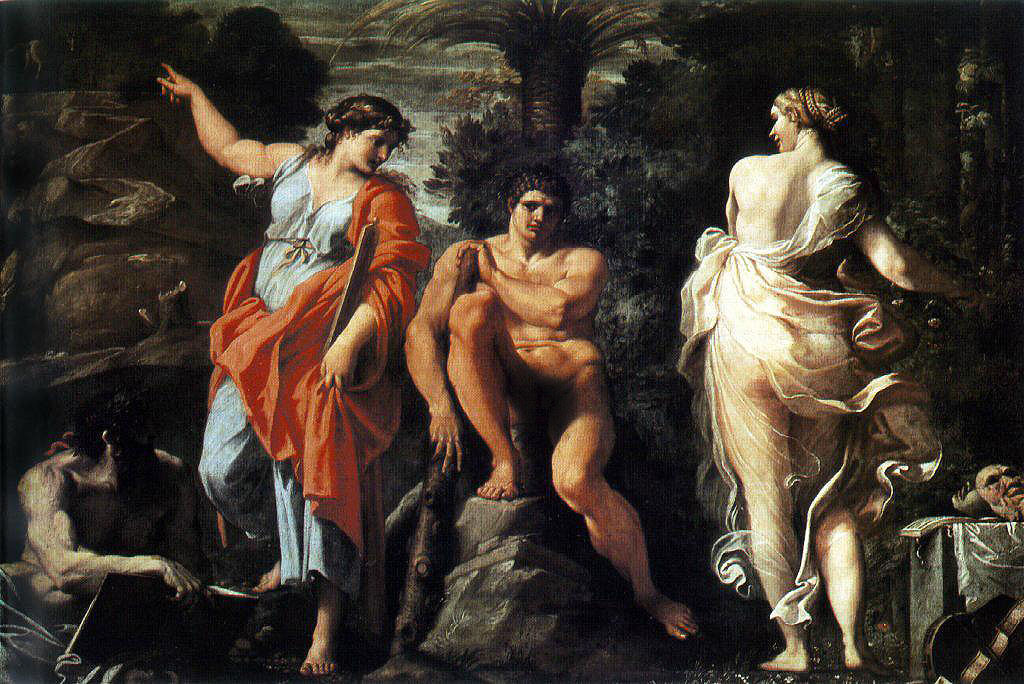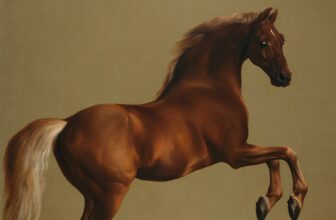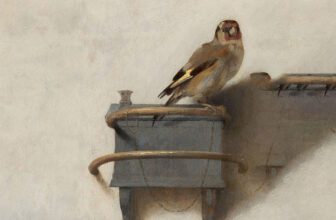
Meaning of The Choice of Hercules Painting
Art has long served as a mirror to human thought, values, and aspirations. Among the many allegorical works that explore the complexities of human nature, Annibale Carracci’s The Choice of Hercules stands out as a profound visual meditation on virtue, vice, and moral decision-making. Painted around 1596, this work captures a pivotal moment of internal conflict and destiny, offering viewers not only an aesthetic experience but also a philosophical reflection. Currently housed in the Museo Nazionale di Capodimonte in Naples, this painting is one of Carracci’s most celebrated allegorical masterpieces.
In this article, we will delve into the story behind The Choice of Hercules, its artistic and historical context, its symbolic richness, and its enduring message that still resonates today.
Who Was Annibale Carracci?
Before exploring the painting, it is essential to understand the artist. Annibale Carracci (1560–1609) was a pioneering figure of the Italian Baroque and a central member of the Bolognese School of painting, which he founded with his brother Agostino and cousin Ludovico Carracci. In an era increasingly drawn toward Mannerism, which often favored stylistic excess and artificiality, Carracci and his circle championed a return to classical clarity, naturalism, and balanced composition.
Annibale is perhaps best known for his Farnese Gallery frescoes in Rome, an exuberant celebration of mythological themes rendered with stunning skill and dynamism. However, The Choice of Hercules shows another side of his talent, introspective, didactic, and rooted in the humanistic values of the Renaissance.
The Story Behind The Choice of Hercules
The subject of the painting originates from classical mythology. Specifically, it’s derived from a tale recounted in the works of Xenophon, a Greek historian and philosopher, in his Memorabilia. In the story, the young Hercules (Heracles) is approached by two women while contemplating his future. One is Virtue (Arete), who offers a path of struggle, sacrifice, and ultimate glory. The other is Vice (Kakia), who tempts him with a life of ease, pleasure, and indulgence.
This moment of decision, the moral crossroads, becomes the foundation for countless artistic and literary interpretations. For Renaissance and Baroque thinkers, the story symbolized the eternal conflict between base desires and noble aspirations, between what is easy and what is right.
The Creation of the Painting
Carracci painted The Choice of Hercules during his time in Rome around 1596, possibly as a preparatory work or companion piece to the larger projects he undertook for the Farnese Palace. While the canvas itself is relatively small compared to his grand frescoes, it is dense with meaning, executed with masterful technique, and packed with philosophical significance.
Carracci’s approach blends naturalism with idealization, a hallmark of his work. His Hercules is muscular yet youthful, confused yet noble, standing at a threshold between two opposing realms.
The painting was commissioned by Cardinal Odoardo Farnese, a key patron of Carracci and a major art collector. The subject matter, virtue over vice, was particularly fitting for a noble family that wanted to align itself with classical heroism and moral virtue. It is believed that the painting may have been used as part of the Farnese family’s decorative or educational program, possibly aimed at young noblemen or scholars.
What Is Happening in The Choice of Hercules?
In the painting, we see a dramatic and emotionally charged scene.
The Figures:
Hercules, at the center, is caught in contemplation. His powerful physique is rendered in classical style, reminiscent of ancient statues. He looks uncertain, reflecting the psychological depth of his inner struggle.
To Hercules’ left stands Vice, depicted as a seductive and alluring woman. She is partially undressed, with soft features and a sensuous pose. She points toward a path lined with pleasures and ephemeral delights.
To his right stands Virtue, fully clothed and dignified. She points toward a rugged, uphill path, a visual metaphor for hardship and righteousness. Her demeanor is calm, her gesture instructive.
Above them, a winged figure, possibly Fame or a personification of divine reward, hovers, offering a crown of laurel to suggest the eternal glory that awaits those who choose the path of virtue.
The Composition:
Carracci’s composition is carefully balanced yet emotionally charged. The central placement of Hercules creates a visual axis, flanked by opposing forces. The background scenery reinforces the narrative: to the right, a steep, rocky path leading toward a distant temple or mountaintop (symbolizing spiritual and moral elevation), and to the left, a shaded grove that suggests indulgence, ease, and temptation.
The tension between light and shadow also plays a symbolic role, Virtue is bathed in a purifying light, while Vice lingers in the shadows, reinforcing their respective moral alignments.
Symbolism and Deeper Meaning
Carracci’s painting is a masterclass in allegorical symbolism. Every figure, gesture, and background element contributes to the narrative of moral choice.
1. Hercules: The Human Condition
Hercules is not just a mythological figure; he stands in for every human being faced with moral decisions. His strength and youth suggest potential, but his uncertainty emphasizes that virtue is not an automatic path, it requires conscious choice and sacrifice.
2. Virtue: The Path of Discipline
Virtue, clothed and composed, points to an arduous path. Her route is unattractive in the short term, yet the promise of honor, self-mastery, and eternal glory lies at its end. The steep road she indicates may include labor, suffering, or rejection, but it ultimately leads to self-actualization.
3. Vice: The Illusion of Pleasure
Vice is alluring and physically attractive, often interpreted as the embodiment of hedonism, laziness, and vanity. Her path offers immediate gratification, but it leads to ruin and despair. Her seductive pose and smile represent the superficial appeal of vice, a warning about the deceptive nature of indulgence.
4. The Divine Realm
The figure offering the laurel wreath, possibly Fame or divine reward, underscores that virtue, though difficult, is recognized and honored. This crown is symbolic of immortality through good deeds, heroism, and legacy.
5. The Setting
The background serves not only as a landscape but also a moral map. Light, elevation, and openness are associated with virtue, while shadows, indulgence, and enclosure are tied to vice.
The Type of Art: Allegorical Baroque Painting
The Choice of Hercules is a quintessential example of allegorical painting, a genre that conveys moral, philosophical, or religious themes through symbolic figures and narratives. This painting also belongs firmly in the Baroque era, albeit early in its development. It combines:
Dramatic tension (seen in Hercules’ expression and pose),
Idealized naturalism (in the anatomical precision and lifelike figures),
Narrative clarity, and
Philosophical depth.
Carracci’s painting avoids the exaggerated emotion and theatricality of later Baroque works. Instead, it strikes a balance between Renaissance composure and Baroque vitality.
Artistic Techniques and Influences
Carracci was a student of the classical tradition but not bound by it. In this painting, he synthesizes:
Michelangelo’s anatomical dynamism, especially in Hercules’ sculpted body,
Raphael’s grace and compositional balance, evident in the arrangement of figures,
And Titian’s warm color palette and atmospheric depth, particularly in the background and the sensuality of Vice.
His use of chiaroscuro (the contrast of light and shadow) adds emotional intensity while guiding the viewer’s eye toward the moral implications of each character.
Furthermore, the painting reflects Carracci’s ambition to elevate painting to the level of philosophy, not merely a decorative art, but a vehicle for moral and intellectual reflection.
The Painting’s Legacy
The Choice of Hercules had a profound influence on Baroque art and beyond. It became a template for moral allegory, inspiring artists such as Pompeo Batoni, Paolo de Matteis, and even Joshua Reynolds in the 18th century. The clarity of its moral message and the richness of its symbolism made it an ideal teaching tool for both artists and thinkers.
During the Neoclassical period, artists and philosophers admired the painting for its embodiment of rational moral values and its roots in classical antiquity. The theme of the moral crossroads was also adopted in theater, literature, and philosophy, reinforcing the painting’s broad cultural impact.
The Choice of Hercules Painting’s Current Location
Today, The Choice of Hercules is housed in the Museo Nazionale di Capodimonte in Naples, Italy. The museum is one of the most important art institutions in Italy, home to a vast collection of Renaissance and Baroque masterpieces. It allows visitors to experience Carracci’s work up close, where the texture, brushwork, and details become even more vivid.
The Capodimonte museum provides historical context, placing Carracci’s painting within a broader narrative of Italian artistic evolution. For art lovers, scholars, and casual viewers alike, the painting remains a highlight of the collection.
Why The Choice of Hercules Still Matters
In an age dominated by rapid gratification, instant rewards, and an overabundance of distractions, Carracci’s The Choice of Hercules speaks with renewed urgency. It reminds us that the most meaningful paths are often the most difficult and that real achievement comes through discipline, effort, and vision.
Carracci does not offer an easy answer. He presents the viewer with a choice, not just for Hercules, but for us all. The painting becomes a mirror to our own decisions: Will we choose fleeting pleasure or enduring purpose? Will we be seduced by vice, or rise through virtue?
Over four centuries after it was painted, The Choice of Hercules remains as compelling and relevant as ever. Through its elegant composition, rich symbolism, and psychological depth, it invites every generation to pause, reflect, and choose.




